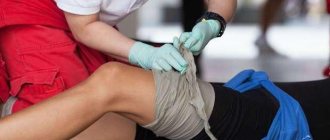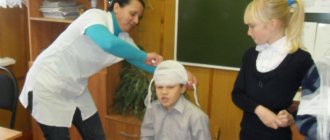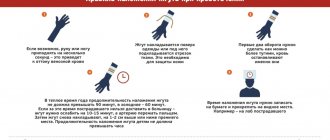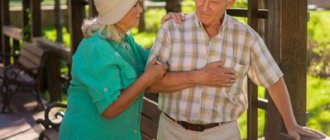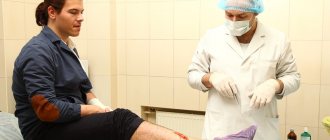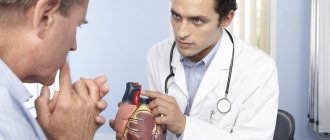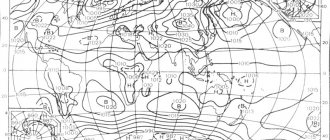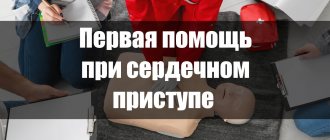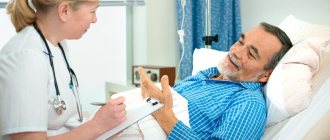Home / Articles / Tachycardia with hypotension: treatment
Tachycardia is a phenomenon characterized by an acceleration of the heart rate. It can be physiological in nature and occur, for example, after physical activity or emotional stress. Usually after some time the patient's condition returns to normal.
If tachycardia is combined with severe hypotension - a decrease in blood pressure, then you should not hope for independent healing; you need to consult a specialist and undergo treatment. The combination of these symptoms indicates disturbances in the functioning of the heart and may also indicate severe intoxication, blood loss and other lesions. Low blood pressure provokes a number of negative changes in the functioning of the body.
Causes
Tachycardia with hypotension can occur under the influence of various factors. The most common reasons include:
- significant blood loss,
- shock resulting from an allergic reaction, injury, toxins and infections,
- vegetative-vascular dystonia, which occurs with the development of specific crises,
- pregnancy - during pregnancy, vascular tone decreases in a woman’s body due to the influence of the hormone progesterone,
- dehydration resulting from prolonged vomiting and diarrhea, significant physical exertion, heat stroke,
- acute inflammatory processes in internal organs, leading to changes in blood distribution,
- heart damage with changes in myocardial contractility,
- taking certain medications,
- systemic consumption of alcoholic beverages,
- atherosclerosis, which causes blockage of blood vessels,
- diabetes,
- severe vitamin deficiency.
Before starting treatment for tachycardia with hypotension, it is necessary to accurately establish and eliminate its cause. In this case, therapy will bring the desired result much faster.
How to relieve an attack of arrhythmia?
Pathologies of the heart and blood vessels are the most common reasons for providing emergency medical care. Typically, resuscitation measures are carried out for myocardial infarction and other acute conditions, but a contraction rhythm disorder can be no less dangerous. In order to understand how to relieve an attack of arrhythmia, you need to know the features of the course of the disease. Additionally, not all cases require treatment. A consultation with a cardiologist will help you find out all the aspects of treating a pathology such as cardiac arrhythmia: how to relieve an attack, and whether surgery is needed.
Arrhythmia Information
Disorders of the heart, characterized by an irregular heartbeat rhythm, are called arrhythmia. In the medical literature, different forms of the disease are distinguished depending on the clinical picture and cause of occurrence. The most common forms include tachycardia and bradycardia. The disease is primarily dangerous due to hemodynamic disturbances and the risk of severe complications. The most dangerous complication of arrhythmia is ischemic stroke.
Being the most active muscular organ, the heart continuously contracts and delivers oxygen along with nutrients to all tissues. Developed external and internal forms of regulation ensure the constancy of hemodynamics. An electrical impulse that causes contraction of muscle fibers occurs in the sinus node of the upper parts of the heart and spreads through secondary nodes to all parts of the myocardium. A slight delay in the transmission of the signal from the atria to the ventricles allows the chambers of the heart to fill with blood before contracting. Thus, the special rhythm of the heart is set by the sinus node. External nervous and humoral influences can only temporarily change the rhythm.
8
24/7
Main forms of arrhythmia:
- Fibrillation is the occurrence of frequent and chaotic contractions of the atria or ventricles myocardium. In the most dangerous form of the disease, ventricular fibrillation, the heart rate can reach 600 beats per minute. A common complication of atrial fibrillation is cardiac arrest.
- Tachycardia is the occurrence of rapid heartbeat (more than 100 beats per minute).
- Bradycardia is the occurrence of too rare myocardial contractions (no more than 60 beats per minute).
- Flutter is a disorder of the rhythm of contractions of the atria or ventricles, characterized by rapid and inconsistent heartbeats. It is also a common complication of heart surgery.
- Extrasystole is the occurrence of an additional contraction immediately after systole. Normally, there is a short rest interval between contractions, during which the chambers of the heart fill with blood.
Clarifying the form of myocardial rhythm disturbance is important in order to understand how to relieve an attack of arrhythmia. Treatment of primary pathology of the cardiovascular system is often required.
Causes and risk factors
The mechanism of development of arrhythmia is in many ways similar to other heart diseases. This may be a consequence of abnormal development of the organ in the prenatal period, an infectious disease or injury. In addition, rhythm disorder may be a complication of the primary disease.
Main reasons:
- Damage to the conductive elements of the heart during ischemia and myocardial infarction.
- Disturbance of the heart valves.
- Consequences of heart surgery.
- Toxic myocardial damage.
- Nervous regulation disorders.
- Thyroid diseases.
- Imbalance of electrolytes in the blood.
- Abuse of caffeine and alcoholic beverages.
- Addiction.
- Breathing disorder during sleep.
- Thickening of the myocardium and enlargement of the heart parts against the background of high loads.
There are also risk factors that can increase the likelihood of arrhythmia. The main factors include:
- Obesity and sedentary lifestyle.
- High blood pressure.
- Diabetes mellitus and atherosclerosis of heart vessels.
- Panic attacks.
- Lung diseases.
- Poor nutrition.
- Old age.
It should be borne in mind that the listed risk factors are common to many cardiovascular pathologies, so heart attack prevention is also a measure to prevent arrhythmia.
An important feature is the origin of the rhythm disorder. A person's heart may begin to beat faster due to physical activity. In this case, the natural form of tachycardia is due to the adaptation of the heart to the high needs of muscle tissue. Pathological tachycardia occurs at rest and does not meet the current requirements of the body.
8
24/7
Symptoms
The disease usually manifests itself during attacks. The rest of the time, the cardiovascular system can operate as usual. That is why the intensity of symptoms largely depends on the frequency of attacks. Some patients do not even notice rare interruptions in the functioning of the heart, while others constantly suffer from insufficient blood circulation. Knowing the characteristics of the course of the disease is important in order to find out how to relieve an attack of arrhythmia at a specific moment.
Possible symptoms:
- Substernal pain.
- Sensation of pulsation in the temple area.
- Dyspnea.
- Dizziness and nausea.
- Brief loss of consciousness.
- Increased sweating.
- Anxiety.
The asymptomatic course of the disease is typical mainly for children and adolescents. The presence of other chronic heart pathologies may aggravate symptoms.
Diagnostic methods
The main way to identify heart rhythm disorders is instrumental diagnosis. Before prescribing therapeutic and diagnostic procedures, the doctor will find out complaints, examine the medical history for previous diseases and risk factors, and also conduct a physical examination. Auscultation of the heart, study of the pulse and tonometry are methods of primary diagnosis. However, outside of attacks, heart function may not be impaired, so additional methods are always required.
Additional diagnostics:
- Electrocardiography is a study of the bioelectrical activity of the heart. To obtain a cardiogram, a special device and electrodes are used that are attached to the patient’s body. Cardiography results indicate a delay in impulse conduction and other disorders of the conduction system.
- Echocardiography – methods of visualizing the heart using ultrasound equipment. A special sensor sends high-frequency sound waves to the myocardial area and forms an image of the organ on the monitor using reflected waves. The method is effective for assessing the severity of the condition and finding the cause of rhythm disturbances.
- Holter monitoring is a long-term study of heart function using a portable cardiogram recording device. During the examination, the patient goes about his normal activities and presses a button on the device if symptoms occur.
- Stress test is a method of recording a cardiogram during physical activity. To stimulate increased heart function, exercise equipment and special medications are used. This procedure is useful if the patient experiences an arrhythmia attack only during exercise.
- Study of heart vessels using angiography. Based on the results, one can judge whether they are blocked or narrowed.
- Blood test for thyroid hormones, minerals and heart attack indicator enzymes.
- Computed tomography and magnetic resonance imaging - scanning the heart and blood vessels to detect the source of the rhythm disorder.
Only a comprehensive diagnosis will help figure out how to relieve an arrhythmia attack in a particular patient. Screening methods are important if there are other heart diseases that can cause arrhythmia.
How to quickly relieve an attack of arrhythmia?
After receiving the results of the examination and making a final diagnosis, the doctor may prescribe medication or surgical treatment. The treatment regimen depends on the form of the rhythm disorder, the frequency of exacerbations and other factors. As a rule, drug therapy is justified for uncomplicated disease.
Medication prescriptions:
- Direct antiarrhythmic drugs as symptomatic treatment.
- Glycosides, beta blockers and other drugs that affect the myocardial conduction system.
- Anticoagulants for blood thinning and stroke prevention.
If the initial prescriptions do not help, you need to make an appointment with your doctor again. The cardiologist can change the dosage and explain how to relieve an arrhythmia attack. In case of fibrillation, resuscitation measures aimed at quickly correcting the rhythm may be required.
Surgical Treatment Options
Surgery is often a more reliable method of rhythm correction. This method of treatment is indicated for severe arrhythmia and ineffectiveness of drug therapy. Depending on the type of pathology, the following methods of surgical correction may be prescribed:
- Radiofrequency catheter ablation is the removal of the affected area in the myocardium using an electric current. This is a fairly simple and safe procedure that does not require open surgery.
- Implantation of devices that normalize heart rhythm during an exacerbation of the disease. A patient with a pacemaker does not need to think about how to relieve an arrhythmia attack.
- Surgery of structural pathologies of the heart and blood vessels.
When the first symptoms of heart rhythm disturbances appear, it is recommended to consult a doctor. Early diagnosis allows for great success. A specialized specialist will be able to explain all the features of such a condition as atrial fibrillation: how to relieve an attack, and what treatment options exist.
8
24/7
Symptoms
Typically, patients who suffer from tachycardia due to hypotension complain that they hear the beat of their heart and can independently count the number of its contractions. They feel chest pain and heaviness in the stomach area, its normal functioning is disrupted. A person suffers from frequent headaches, and dizziness is a common complaint. An increased pulse with low blood pressure is manifested by an unreasonable feeling of anxiety.
Signs of low blood pressure also include:
- drowsiness,
- general weakness and bad mood,
- trembling in the body,
- increased sweating.
With a pronounced decrease in blood pressure, the blood supply to the heart and brain is disrupted. Patients experience nausea, darkening of the eyes and loss of consciousness.
Treatment
Treatment of tachycardia with hypotension depends on the reasons that provoked the pathological changes. Typically, drugs that slow your heart rate also lower your blood pressure. Therefore, the therapy of the pathology is complex and consists of a whole range of means. Taking any medications on your own is strictly prohibited.
The patient must not only take the prescribed medications, but also follow the doctor’s recommendations. You need to follow a daily routine and a special diet, and avoid stress. You should stop smoking and drinking alcoholic beverages.
Experienced specialists at the medical center in Lyublino treat tachycardia due to hypotension. Doctors have extensive experience and successfully cope with pathology. To make an appointment and for more information, please call.
All articles
5% discount Print coupon from our website
Ask your question on the website Get professional advice!
Medications
To prescribe effective treatment for arrhythmia and low blood pressure, it is necessary to find out their root cause. If the diseases are caused by pathologies of the autonomic nervous system or constant stress, then sedatives are prescribed. If the disease is organic in nature, then tranquilizers are more effective than conventional sedatives. But they are taken under the strict supervision of a doctor, in a hospital.
Attention! In total, there are three groups of drugs that are prescribed by a cardiologist to normalize heart rhythm and blood pressure.
Sedatives
The peculiarity of sedatives is that they can be used without a doctor’s prescription for preventive purposes. With the help of sedatives, blood pressure is normalized and heart rhythm is restored. Attacks of insomnia cease to bother you, and general emotional tension is relieved.
After using sedatives, nervousness is slightly reduced, without dependence or drowsiness.
Sedatives have a combined composition. Among the components: bromides, herbal medicinal preparations and barbiturates. As already noted, the most popular sedatives for low blood pressure and heart rhythm disturbances are motherwort and valerian.
These sedatives are used for preventive purposes to relieve emotional stress. To do this, motherwort is taken 30-50 drops with 50 ml of plain water. It is undesirable to take such drugs if a person does not experience obvious discomfort.
Tranquilizers
If a person is intolerant to antiarrhythmic drugs, then treatment is carried out using tranquilizers. They are used to restore heart rhythm. Tranquilizers differ from sedatives in that they lower blood pressure and reduce heart rate during tachycardia.
The use and dosage of tranquilizers is only as prescribed by the attending physician. Among the drugs used are Diazepam, Elenium and Phenazepam. If pathological changes in the heart cause a rhythm disturbance, then, in addition to relieving the arrhythmia, you need to treat the underlying disease. A competent doctor, as a rule, will be able to reduce the dosage while still leaving the therapy effective.
Read also: How many extrasystoles per day is normal? When is treatment needed?
Antiarrhythmic
A group of these drugs are used to normalize heart rhythm. In this case, antiarrhythmic drugs will not be prescribed if the patient needs to relieve pain or reduce the likelihood of recurrence of arrhythmia. With the help of antiarrhythmic drugs, the conductivity of the heart muscle is improved and metabolic processes are restored.
Typically, the following antiarrhythmic drugs are prescribed:
- Aymalin.
- Ethacizin.
- Pulse norm.
- Novocainamide.
- Quinidine.
- Rhythmonorm.
In this case, the attending physician selects the drug and dosage, assessing the severity of the disease. All instructions and prescriptions of the cardiologist or arrhythmologist must be followed in full. To maintain effectiveness, do not stop taking it prematurely or reduce the dose. Because in this case the risk of relapse increases.
